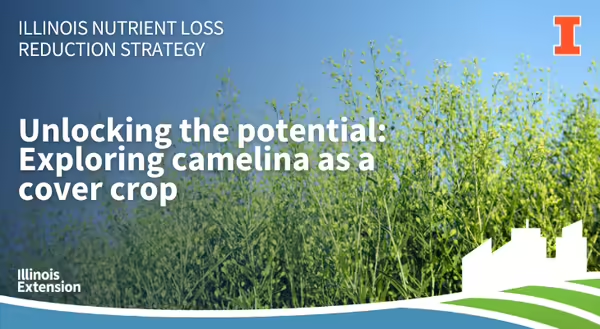
As the use of cover crops continues to grow across Illinois and the country, non-traditional crops are being researched and explored as potential cover crops including camelina. In the June 2023 podcast episode, we hear from Dr. Joel Gruver, Professor of Soil Science and Sustainable Agriculture at Western Illinois University, about camelina as a cover crop and his research. Dr. Gruver has spent the past 16 years taking the science and translating it into understandable, memorable ideas for both students and farmers. His primary focus is on organic cropping systems and addressing production questions. Dr. Gruver is also conducting research on the use of camelina as a cover crop.
What is camelina?
Camelina is an ancient oil seed in the Brassica family that originated in Europe. It is currently grown as a cash crop in the western part of the United States and Canada for oil, but is being studied as a cover crop in Illinois. Camelina is drought, cold, and pest tolerant, which makes it a resilient cover crop option.
Why camelina?
Cereal rye is a commonly used and reliable cover crop, however, it comes with additional considerations that camelina can help address. Depending on termination timing, cereal rye can produce a large quantity of biomass, which is not the case for camelina. There is also the possibility of allelopathy for cereal rye proceeding corn or nitrogen tie-up, which is less likely to occur with camelina.
Camelina has spring and winter varieties. Winter camelina is extremely winter hardy and can survive Illinois winters. Due to the winter hardiness, camelina can be planted after corn or soybean harvest up until early November as long as there is moisture to allow camelina to establish. Dr. Gruver recommended planting your camelina closer to October 1 but acknowledged the larger planting window. He mentioned planting earlier than the beginning of October runs the risk of the camelina bolting prior to winter, which will decrease survivability.
Camelina as part of a mix
Camelina can be used as a stand-alone cover crop or added to a mix. Dr. Gruver suggested adding camelina to cereal rye and reducing the cereal rye planting rate, but there are considerations to make when adding in camelina. Camelina has a small seed size compared to cereal rye, which is why he suggested reducing the cereal rye planting rate. Camelina doesn’t need to be planted deeply, so it can be spread on the soil surface while the cereal rye seed is drilled. You could also consider using vertical tillage to work the camelina seed into the soil at a shallow depth. Cereal rye and camelina can be terminated at the same time using standard burn-down practices or tillage.
Additional cover crop thoughts
It is important to take the whole system into consideration when using cover crops. Including cereal rye in a mix prior to planting soybeans will help capture nutrients that might otherwise be lost in your corn/soybean rotation if the field were to sit fallow and can provide a low-risk opportunity. Dr. Gruver also emphasized the utilization of camelina or other species in a mixture with cereal rye to allow the cover crop to grow a little longer in order to maximize the benefits.
For additional information on cover crops, Dr. Gruver recommended the Midwest Cover Crop Council (MCCC) website. Within the website, you can find a cover crop decision tool for row crop production as well as information on currently recommended cover crop species for the Midwest. Camelina is being discussed to be added to the list of recommended species. MCCC released the third edition of the Midwest Cover Crop Field Guide in 2021 and the updated guide is available for purchase through Purdue University.
ABOUT THE AUTHORS
Rachel Curry is an Agriculture and Agribusiness Educator for two Nitrogen Priority Watersheds (Flint-Henderson and Lower Rock River Watersheds) and is housed in the Galva office of the Henry, Mercer, Rock Island, and Stark Counties Extension Unit. Rachel earned a BS in Environmental Studies from Knox College and an MS in Environmental Science and Soil Science from Iowa State University with an emphasis on soil fertility. She is interested in sharing information on the Illinois Nutrient Loss Reduction Strategy and agricultural conservation practices through discussion and outreach.
Nicole Haverback is a Watershed Outreach Associate for two Phosphorus Priority Watersheds (Embarras and Little Wabash River Watersheds) and is housed in the Effingham office of the Clay, Effingham, Fayette, and Jasper Counties Extension Unit. Nicole earned a BS in Agriculture and Rural Policy Studies from Iowa State University in May of 2022. She is interested in sharing information on the Illinois Nutrient Loss Reduction Strategy and agriculture conservation practices through discussion and outreach.
Sam Henry is a Research and Extension Experience for Undergraduates (REEU) intern working with Rachel and Nicole during Summer of 2023. She is an Agricultural Engineering student at the University of Illinois. Outside of classes, she works with Dr. Rodriguez in his BioMASS Lab and learns about alternative agricultural methods in Illini Urban Farmers. She is in her third year and is passionate about the nexus of clean water, sustainable agriculture, natural resources, and sustainability.
ABOUT THE BLOG
At Illinois Extension, we’re working to improve water quality at home and downstream. Every month, our watershed outreach associates will bring you stories highlighting agricultural conservation practices, current research projects and results, and from the field farmer interviews. The Nutrient Loss Reduction blog covers conservation practices recommended by the Illinois Nutrient Loss Reduction Strategy, timely updates, farm safety, and new decision tools to help farmers and producers reduce the nutrients leaving their field. Want to get notified when new blog posts are available? Subscribe at go.illinois.edu/SubscribeINLRS.